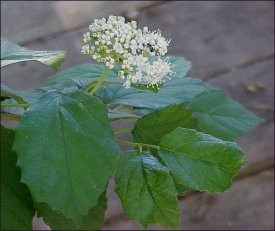
Arrow-wood
by Sharon LaPlante
Viburnum dentatum is a deciduous shrub generally
listed in the Caprifoliaceae or honeysuckle family, however some
taxonomists have found evidence that viburnums should be placed in the Adoxaceae,
or elderberry family, and some references do classify them as such.
Arrow-wood is composed of several different varieties (polymorphic).
The species of arrow-wood that occurs in our area is Viburnum dentatum
var. scabrellum.
Arrow-wood grows in a variety of habitats including poorly
drained riverine areas, stream banks, and bogs, as well as drier, well drained,
upland woodlands and pine flatwoods. Viburnum
dentatum var. scabrellum occurs in Florida from Hernando County
northward to southwest Georgia, and westward to eastern Texas.
It has a multi-trunked habit, similar to wax myrtle, and
attains a mature height of 9 to12 feet. It
will generally produce suckers that will eventually spread to form a thicket.
The leaves are opposite, simple, and ovate with the
occasional lance shaped leaf. They
are generally 2 - 3 inches wide and 3 - 4 inches
long. The leaf margins are
dentate, or toothed, and the tips of the teeth may be sharply pointed or blunt.
The leaves have distinctive lateral leaf veins and the upper and lower
surfaces of the leaves have a rough surface.
The leaves may turn yellow, orange or purple in the fall.
Round topped clusters of small white flowers appear in the
late spring - mid-May to early June in Central Florida.
The individual flowers have five petals with five protruding stamens.
The flowers provide a nectar source for many different insects including
bees and wasps.
The fruit contains one seed and is oval in shape.
It is green when immature and turns to blue-black at maturity, which
generally occurs in the summer. It
is consumed by a variety of wildlife including songbirds, game birds, and
mammals.
Arrow-wood's ability to grow in a wide variety of habitats
make it an excellent choice for the home landscape. Not only is it very adaptable, it also provides showy spring
blooms, beautiful summer fruit, attractive fall color and food for wildlife.
Arrow-wood can be planted in the home landscape in masses, hedges,
borders, or as individual specimens.
Arrow-wood grows best in part-shade with ample moisture until it is
established. It generally does not
require watering once it is established unless it is located in the full sun
then it may become stressed during periods of drought unless it is located in a
moist area. Pruning is not
necessary in order to maintain dense growth.
The easiest form of propagation is by the use of cuttings
because the seeds take as long as three years to germinate.
Four to six inch semi-hardwood cuttings taken in the fall will produce
the best results because the mature portion of the stem contains adequately
stored food reserves which help to manufacture new roots.
Root cuttings may also be obtained if there are suckers at the base of
the plant.
by Sharon LaPlante
Bir,
Richard E. Growing &
Propagating Showy Native Woody Plants.
University of North Carolina Press: N.C.
1992
Godfrey,
R.K., and J.W. Wooten. Trees,
Shrubs, and Woody Vines of Northern Florida and Adjacent Georgia and Alabama.
University of Georgia Press: Athens, GA
1988
Nelson,
Gil. The Trees of Florida.
Pineapple Press: Sarasota, FL 1994
Taylor,
Walter Kingsley. Florida
Wildflowers in Their Natural Communities. University Press: Gainesville, FL.
1998
Wasowski,
Sally. Gardening with Native
Plants of the South. Taylor
Publishing: Dallas, TX 1994
Return to the Main Page
All material on this site © Hernando Chapter of the FNPS. The materials on this website may be copied and distributed without permission, provided that it is used for non-commercial, informational or educational purposes, and you acknowledge this site and the Hernando Chapter of the Florida Native Plant Society as the source of publication.